Looking to add a unique and interesting snake to your collection? The Blue Eyed Leucistic Ball Python is guaranteed to be a great choice.
The blue eyed lucy is one of the rarest Ball Python morphs and is a prized reptile.
Known as the BEL ball python it is a beautiful white snake with icy blue irises around black pupils. Some even have a beige stripe along the spine.
This morph tolerates handling and adapts well to captivity. They are great for any herpetologist who wants a unique reptile.
Keeping reading to learn everything you need to know about your blue eyed snake.
What Is A Blue Eyed Leucistic Ball Python?
Known as a bel ball python it is a white Ball python morph.
They are a white snake with icy blue eyes and black pupils. Because of their eyes they are not classified as an albino snake, but their body does lack pigment.
These docile snakes can grow to be up to five feet long and are great for first time owners.
Their history is rooted deep in common ball pythons from Africa.
Ball pythons are native to the grasslands and forests of West and Central Africa and first became popular with herpetologists in the 1980s.
In 1992 the first recessive gene was isolated by professional snake breeders and the first clutch of morphs was born.
Breeders have since discovered thousands of morph combinations and the Blue Eyed Leucistic Ball Python is one of them. They can be expensive and difficult to find – breeders typically charge $700 per snake.
What Makes A Blue Eyed Leucistic Ball Python?
This snake is very complicated to breed and is bred from two of five morphs: Mojave, Lesser, Butter, Het Russo and Phantom. The most commonly used genes are Mojave, Lesser and Butter.
They require the genes of two different morphs bred over three generations.
Some example breeding pairs include:
- Mojave and Lesser
- Butter and Mojave
- Phantom and Butter
These morphs are very difficult to produce and are called designer pythons because it is considered almost impossible for them to naturally occur in the wild.
What We Like About BEL Ball Pythons
Pros
- Ball pythons are a well-established and popular pet.
- They are docile and tolerate handling well.
- This morph is extremely unique and rare.
Cons
- They can be fussy eaters during the cool season.
- Very expensive to purchase this morph – $400 to $600.
- This species is shy and can stress easily.
Species Appearance
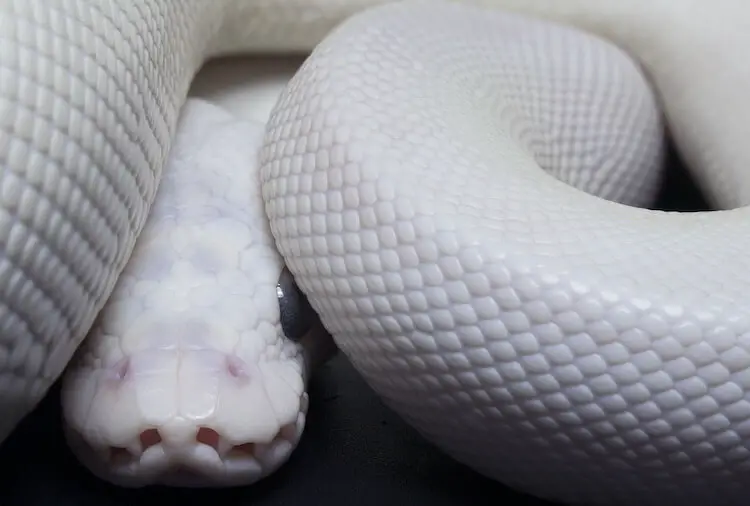
The classic bel ball python is a bright white snake with no scale patterning or pigmentation at all. Their only real pigment occurs in their blue eyes.
Their eyes are an icy blue and are truly unique!
Some species are white to off-white in color and have pale beige-yellow banding along their spines. This is less common and considered undesirable, but they are near identical in appearance and genetics.
They have little spurs at the sides of their vent that are believed to be the remnants of their ancestors’ vestigial legs.
How Big Does A Blue Eyed Leucistic Ball Python Get?
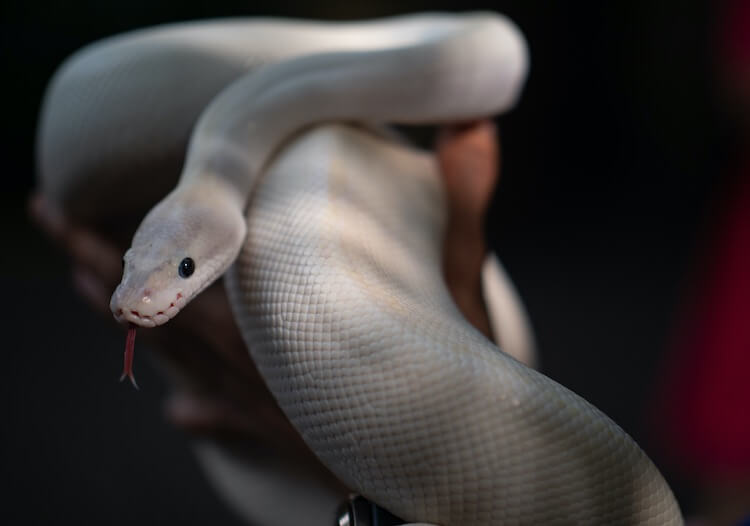
Males will normally grow to three feet within their first two or three years. Females are slightly larger and can reach six feet but are typically five feet long.
Despite their white body, and different appearance, the growth of this morph is the same as their wild-type relatives.
Hatchlings are born ten inches long and take three years to reach adult size.
Females have a longer period of growth due to their size difference.
Ball pythons have stocky bodies and are prone to becoming overweight due to their sedentary behaviors. Adults should rarely weigh more than 1,500 grams for males, and 1,750 grams for females. Many healthy females can reach 1,900 grams.
Regular weight monitoring is recommended to ensure your snake is keeping a healthy size.
Blue Eyed Leucistic Ball Python Care Sheet
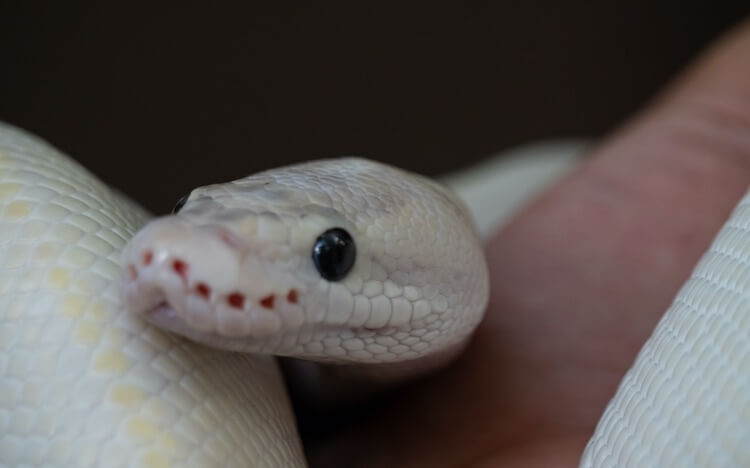
The bel ball python is a docile snake that is great for beginner keepers.
If this beautiful beginner snake has captured your attention, read on to learn how you can bring one home to a wonderful life…
Ball Python Diet
In the wild ball pythons are carnivores and prey on small rodents and birds.
The Blue Eyed Leucistic Ball Python’s diet is very simple – hatchlings should be fed pinky or fuzzy mice and adults should have rats. Aside from what to feed your snake, you should know when to feed them and how much. This changes as your snake ages:
- Hatchlings should eat pinky or fuzzy mice every five to seven days.
- Juveniles (six months to three years) should be fed rodents every seven to ten days that are no larger than the widest part of their body.
- Adults should be fed medium-sized rats every ten days.
Pinky or fuzzy mice are appropriately sized food items for hatchlings, but a transition to rats, should be helped as soon as they grow into Juveniles, because rats are higher in fat and allow you to feed an adult with a preferable one-item meal.
We highly recommended that you only feed a frozen-thawed diet.
Live prey can bite or scratch your snake causing permanent eye damage or infections.
To thaw out rodents you should:
- Place the rodent in a refrigerator the night before feeding.
- The next morning place the rodent into a bag and then let it sit in warm water.
- Once it reaches 97 – 100°F you can feed.
Prey variation is exciting for a snake and helps to provide them with enrichment.
Consider offering a chick occasionally.
Lastly, it is important to keep a water bowl large enough for your snake to soak in. It will help them shed and maintain hydration. It should be cleaned once every two days to prevent any mildew growth.
Known Health Issues
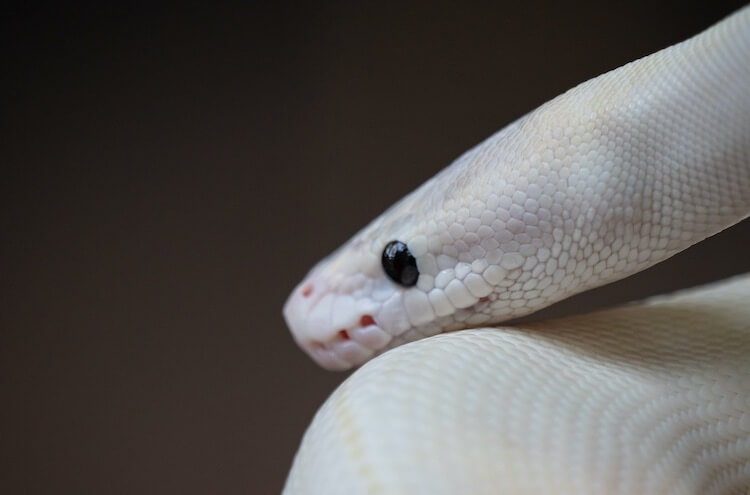
Ball pythons are known to have very long lifespans of 20 to 30 years – the oldest in captivity is 48! Blue Eyed Leucistic Ball Pythons have the same lifespan.
They are one of several designer pythons that rarely show any genetic problems such as head wobbles.
However, these morphs are still subject to health issues associated with living in captivity:
- Anorexia
- Inclusion Body Disease
- Internal Parasites
- Mites
- Mouth or scale rot
- Respiratory infections
After purchasing a snake you can choose to quarantine them to make sure they are heathy. Quarantine should last for 90 days.
You can also contact a vet for tests such as fecal exams, blood panels, and x-rays to determine if there are any health problems.
During quarantine you should also record how often they are soaking.
If you have a non-water snake that is soaking daily it could indicate that they have mites and he is trying to drown them. Mites spread easily in transit, and so must be eradicated before bringing a new snake into your collection.
Signs They Are Healthy
- Sheds come off in full pieces with eye caps.
- Exploring at night.
- Eating on time.
- Docile behavior.
Sickness Symptoms
- Increased basking.
- Wheezing or clicking sounds.
- Prey refusal.
- Over-soaking.
Blue Eyed Leucistic Ball Python Enclosure
Wild ball pythons are from the African grasslands.
The bel ball python morph shares the same primitive instincts as their wild-type relatives and need the same enclosures.
A few key points to consider before we share tank sizes and setups:
- Do not place the tank directly in front of a sunny window as it may overheat.
- The tank must have a basking area in addition to heating.
- This species is shy so you must provide plenty of hiding places and huts.
Enclosures for bel ball pythons should be exactly the same as any ball python enclosures.
It should be made of either PVC, plastic, or glass and needs a secure top. Using PVC is best because it gives your snake more privacy. Plastic also retains humidity and keeps constant temperatures better.
Glass terrariums can work but they need more fake foliage and hides to help your snake feel safe. They are also inefficient at maintaining humidity and require more frequent misting.
Tank Size
- Hatchlings will do perfectly well in a 10-gallon enclosure.
- Juveniles will thrive in a 20-gallon.
- Adults should be in a 40-gallon tank.
Adding hatchlings or juveniles into an adult sized 40-gallon tank will cause stress.
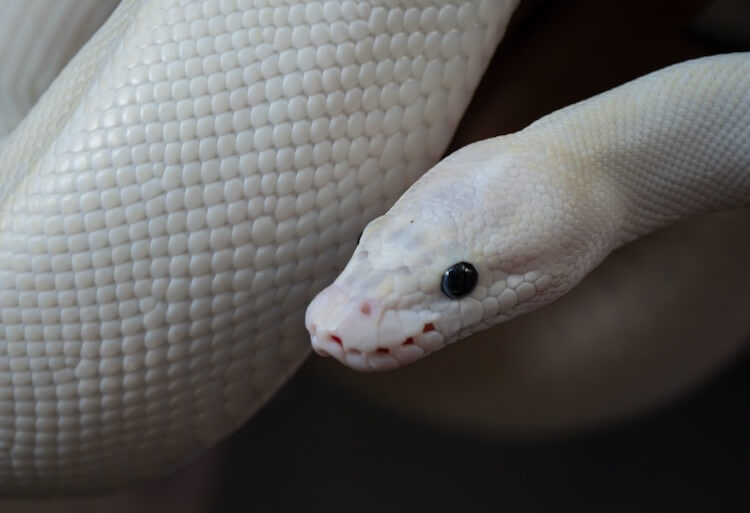
Inside their tank you need a minimum of two hides – one on each end. The more hides the better. Add plants, sticks, bark, moss, and other clutter to help them feel safe when venturing out.
Tank Set Up
- Tank Type: plastic or PVC.
- Tank Size: 40-gallon.
- Lighting: basking lamp.
- Substrate: cypress mulch or organic topsoil.
Your snake should have a basking area of 88 – 92°F during the day.
This can be accomplished by purchasing a heating lamp connected to a thermostat. You can use the basking lamp to keep a light cycle to allow them to maintain to their internal rhythm.
A basking area should be located at one end of the tank and not in the center.
The cool side of their enclosure should be around 76 – 80°F with an ambient temperature of 82 – 83°F between the two. A ceramic heat emitter is best and will provide constant heat even when the basking light is turned off.
They benefit from a constant humidity of between 50 – 60%.
If humidity is 80% (or more) for any sustained period of time it can cause a respiratory infection. A hygrometer is necessary to monitor humidity and choosing a good substrate will help to maintain it.
The best substrates for Blue Eyed Leucistic Ball Pythons are earthy, moisture retaining ones. This can include cypress mulch or any organic, perlite-free topsoil. Both of these options retain moisture and help with humidity.
Cleaning & Misting
You should clean your snake’s enclosure every six weeks.
Daily spot cleaning for shed and feces will help to maintain the enclosure in between deep cleans.
Spot cleaning is also a great opportunity to examine their feces for the right ratio of urates to fecal matter.
With the right humidity you should ideally be able to mist your ball python once or less per day.
If you notice the humidity dropping below 40% – mist more often.
It is possible to mist too frequently and oversaturate the substrate. This will lead to mold and mildew and forces you to clean the enclosure more often. If you experience this problem then consider adding a drainage layer to help the soil stay moist but not wet.
Typical Behavior
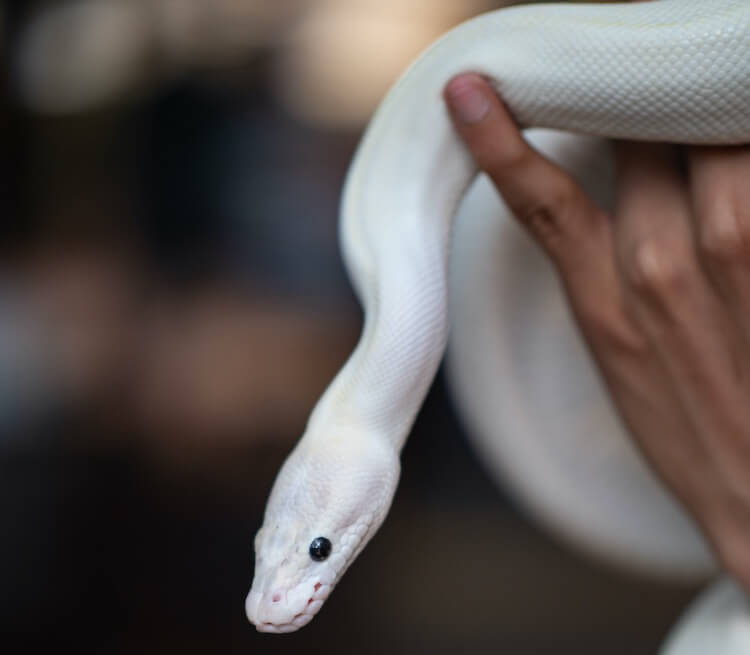
Ball pythons are sedentary during the day (hiding away from the sun and heat) and emerge at night to explore, hunt and find mates.
These snakes avoid each other in the wild and only ever interact with one another when breeding.
It is not recommended to cohabitate this species.
Blue Eyed Leucistic Ball Pythons are active hunters and use constriction to subdue their prey.
They strike, coil quickly and tightly around their prey and wait for it to become unconscious or dead.
During the cool season they typically stop feeding for several months and slow their metabolism.
In captivity the slightest change in humidity or temperature can send your bel ball python into a feeding strike. Most morphs will start to feed on their own again once conditions are returned to normal.
Do Ball Pythons Like Being Handled?
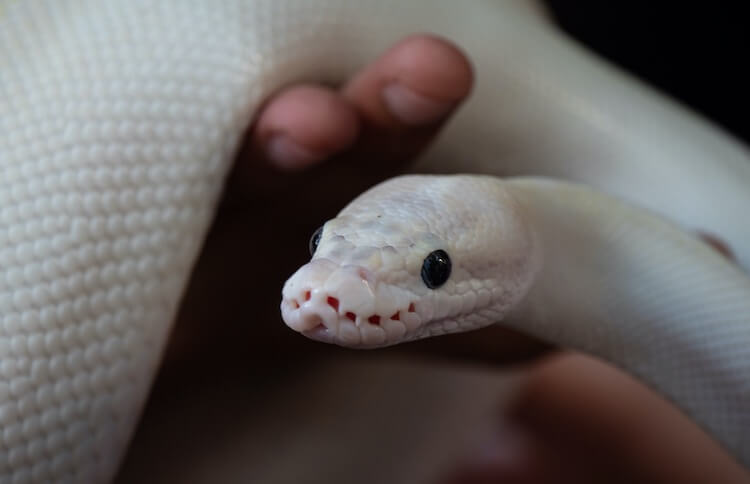
Their friendly temperament and tolerance to handling make this snake great for beginners.
After bringing home your Blue Eyed Leucistic Ball Python they will need a few days to adjust. To avoid overly stressing your snake minimize interactions for the first two weeks.
Before and after touching any reptile you should thoroughly wash your hands to prevent the spread of diseases like salmonella.
Start with 10 minute handling sessions for a couple of weeks and only increase the duration if your snake tolerates it.
Here are a few tips for picking up your new Python:
- Gently rub the back of your snake with your hand.
- Watch for signs of stress or fear – i.e. jerking its head around or trying to ball up.
- Pick the snake up by the broad portion of its body.
- Support the rest of the snake’s weight as you pick it up.
This species is like any snake and is capable of biting. However, they rarely bite and are docile and even-tempered
These nonvenomous constrictors are not capable of delivering a serious bite.
If you notice the snake is in shed or has eaten within the last 24 hours do not handle.
To avoid confrontation do not force a negative interaction.
How Much Is A Blue Eyed Leucistic Ball Python?
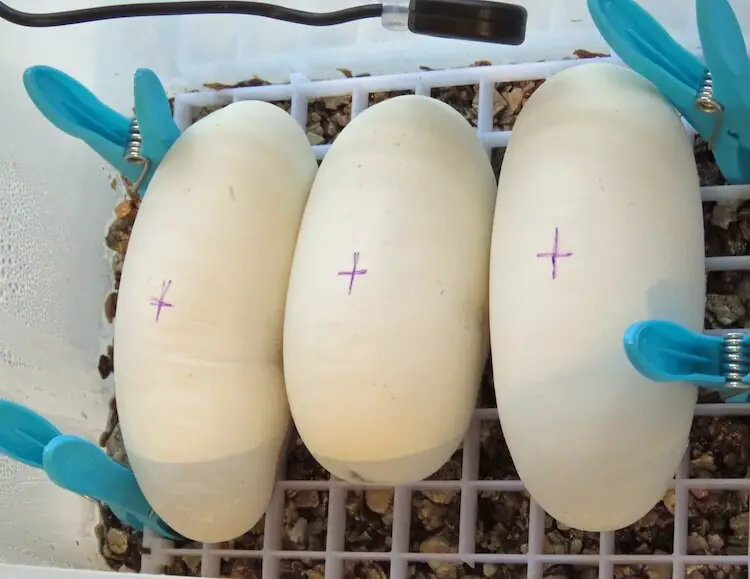
Most bel ball pythons are sold for $400 to $600.
If a snake has beige dorsal striping they will be cheaper. However, Stark-white snakes can cost over $600.
At birth this species is approximately 10 inches and appears a translucent pinkish-white. They eventually turn white.
Blue Eyed Leucistic Ball Pythons are hard to find because it is very difficult to breed them.
Finding reputable breeders is even more challenging.
When picking a Blue Eyed Leucistic Ball Python make sure to inspect it for any scars, injuries, mouth rot, and scale rot. If their ribs slope down at a dramatic angle they are malnourished.
| Blue Eyed Lucy Facts | |
|---|---|
| Common Name | Blue Eyed Leucistic Ball Python |
| Scientific Name | Python Regius |
| Price | $700 to $1,000 |
| Size | 2 – 5 feet long |
| Lifespan | 20 to 30 years |
| Diet | Rodents |
| Tank Size | 40 – 60-gallon tank |
| Humidity & Temperature | Temperature: 76 – 93°F Humidity: 50 – 60% |
| Popular Alternatives | Corn Snake and Brazilian Rainbow Boa. |
Summary
The Blue Eyed Leucistic Ball Python is an incredible and popular morph.
They are docile, tolerate being held, and move slowly – a comforting combination for most beginners.
If you want a smaller snake with more personality then look towards a corn snake. Another popular option is the Brazilian Rainbow Boa.
These long-lived snakes are a wonderful to any reptile collection.
Do you think you have been convinced? Drop us a comment below to let us know…

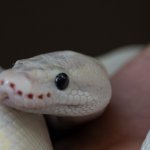
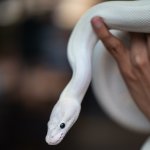
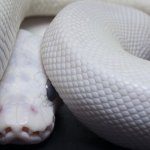
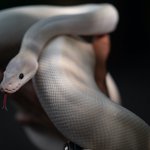
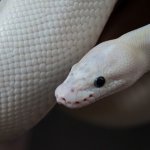
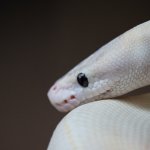
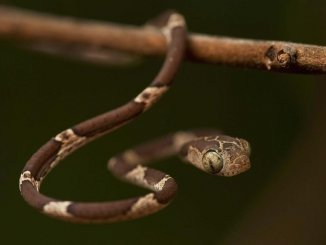
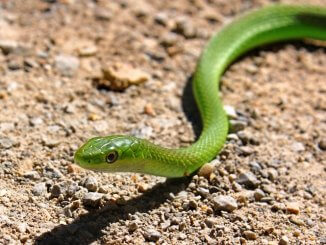
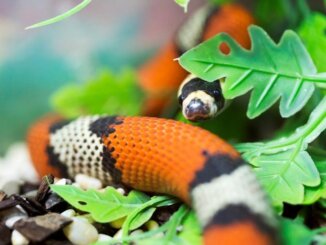

Already made the purchase about a month ago. I had a boa that lived 25 years and died about 10 years ago. I always pondered the thought of purchasing another snake when a ran across a blue eyed Lucy at a local petshop. I knew he was the snake for me as soon as I laid eyes on him. He is as white as snow. Didn’t realize how uncommon he was until now. Your article is on point.
They actually aren’t uncommon at all. If you go to Morph Market and search for them you’ll find hundreds.
I was wondering how to feed mine. Just leave the thaw in the cage untill she eats it or do i play with it to make it seem alive?
Depends on the snake. I have some that won’t eat unless they have the f/t rodent left in their enclosure for several hours and I have some that I have to do the zombie rodent dance to get them to take it.
These are in no way the rarest morph, in fact they are very easy to breed and very common. Just look on Morph Market, there’s tons available usually between $300-400. They can be made with any 2 of the following genes: Bamboo, Butter, Lesser, Mojave, Russo Het Leucistic, Phantom, Mystic, Mocha, Special, and Daddy Gene.
Also you state that “They are great for any herpetologist who wants a unique reptile,” but a herpetologist isn’t the term for someone who keeps reptiles, it’s a term for someone who actually studies reptiles and amphibians. It’s no different than saying someone is a biologist. So while someone who is a herpetologist might keep reptiles as pets, it’s not the same as a herpetoculturist.
Even with those genes, success rates in breeding a true Blue Eyed Leucistic are less than 25% and may take generations. But you can get breed and buy similar morphs (sometimes wrongly identified BEL) quite easily.
But you are right in that they have become more common, most likely due to growing demand.
I’m so happy I finally hatched 3 bells. I have been trying for awhile now. Beautiful little snakes. Can’t wait to for them to grow up.
We’re happy you had success with them! Not the easiest breeding for sure.